|
Before the troops moved onto Block 21 in 1915, and then into the new armory building upon their return from France at the close of the Great War in 1919, the original unit of the First Cavalry had occupied a number of buildings on North Clark Street. They leased their first building, a riding academy, in 1902, but soon outgrew it and expanded to other buildings along that stretch of the east side of Clark Street between Goethe and Schiller Streets.
|
Chicago Daily Tribune, July 30, 1902
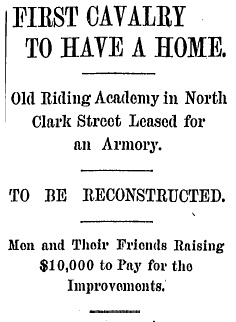
The First Cavalry, I.N.G., is soon to have an armory, with 30 horses, a drilling arena, equipments, dressing rooms, reception room, and officers’ quarters, according to plans of Col. E.C. Young of the regiment, which he hopes to have brought to a successful issue by Sept. 1 For the purposes of the armory the building at 521 to 527 North Clark street, formerly used as a riding academy, has been leased, and is being reconstructed and enlarged. An expenditure of $10,000 is to be made, all of which is to be contributed by the members of the regiment and their friends.
The building, when remodeled, will have a ground area of 75x100 feet and will be three stories high, one of the changes being the addition of a story to the structure. The drill arena will be 75x100 feet. The rooms at the front of the building will have a depth of 25 feet and will be arranged as follows: First floor, reception rooms, from which the work in the arena may be viewed by visitors; second floor, officers’ offices; third floor, men’s lockers, bathing and dressing rooms.
At the rear of the arena on the first and second floors will be stables for the horses, and on the third floor will be the storerooms for the trappings and feedrooms.
Drill Night for Each Troop.
Troops A, C, E, and F of the regiment, which are made up of Chicago men, will each be assigned a night for drill each week, and this drill will be under the direction of their captains. With a full equipment of horses Col. Young anticipates that this drill work will be productive of good results. The securing of the necessary horses, however, is something of a problem, as the enterprise must be carried on wholly by money subscribed by members of the troops and friends of the regiment.
“Although many of the men own horses, it is impossible for them to ride them to and from the armory on drill-nights,” said Col. Young. “Many of the members live miles away from the armory, and in order to do successful work we must have the horses kept in the armory. The men are enthusiastic, and we are finding that we have many friends who are ready to help us.”
Other troops of the regiment are stationed as follows: Troop B at Bloomington, troop D at Springfield, Troop G at Peoria, and troop H at Macomb. These troops have their local armories and drill grounds. The regiment is the only complete regiment of cavalry in the United States outside the regular army.
Troop A Organized in 1891.
Troop A of the regiment was organized in June 1891, and in that same month Troop B of Bloomington was transferred from infantry to cavalry service. An independent troop was organized that year, and during the railroad strike in 1894 these did active service. Later it was admitted to the National guard as Troop C. Other troops were gradually formed and in 1897, when war with Spain was declared, Maj. Young headed a movement to fill the regiment, and this was accomplished. During the spring the regiment was mobilized and sent to Chickamauga, where it remained until August and was then returned to Illinois and mustered out from the United States service, but at once returned to the National guard.
The regiment was called upon for duty at Virden to suppress the riots attending the strike in the coal mines and remained there until order was restored.
|
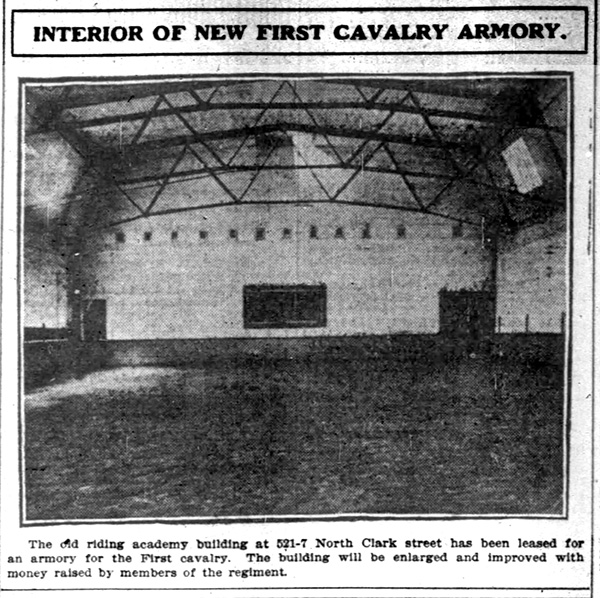
Chicago Daily Tribune, May 12, 1906
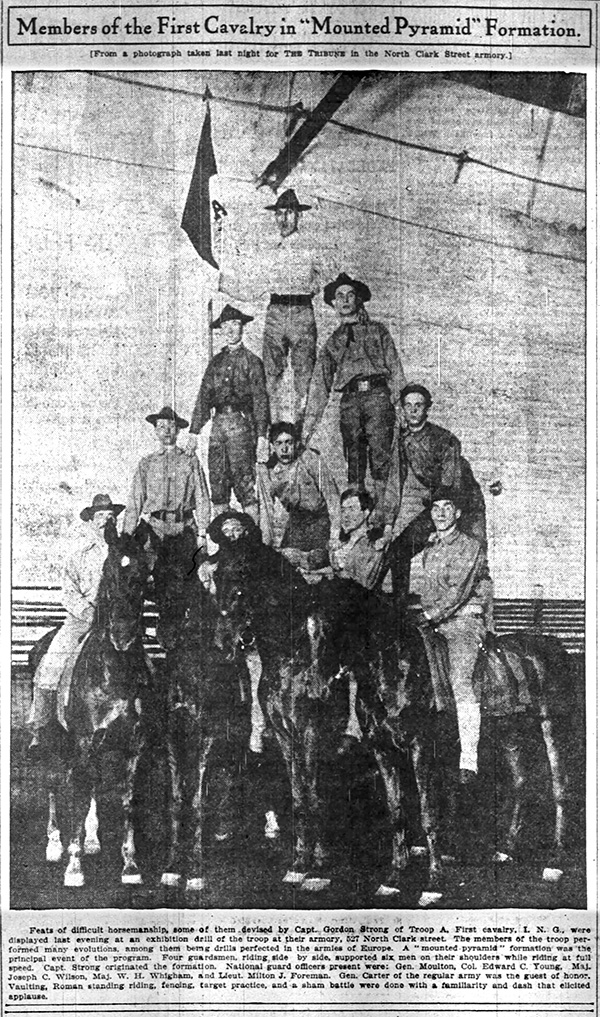 |
|
Chicago Daily News, July 10, 1909
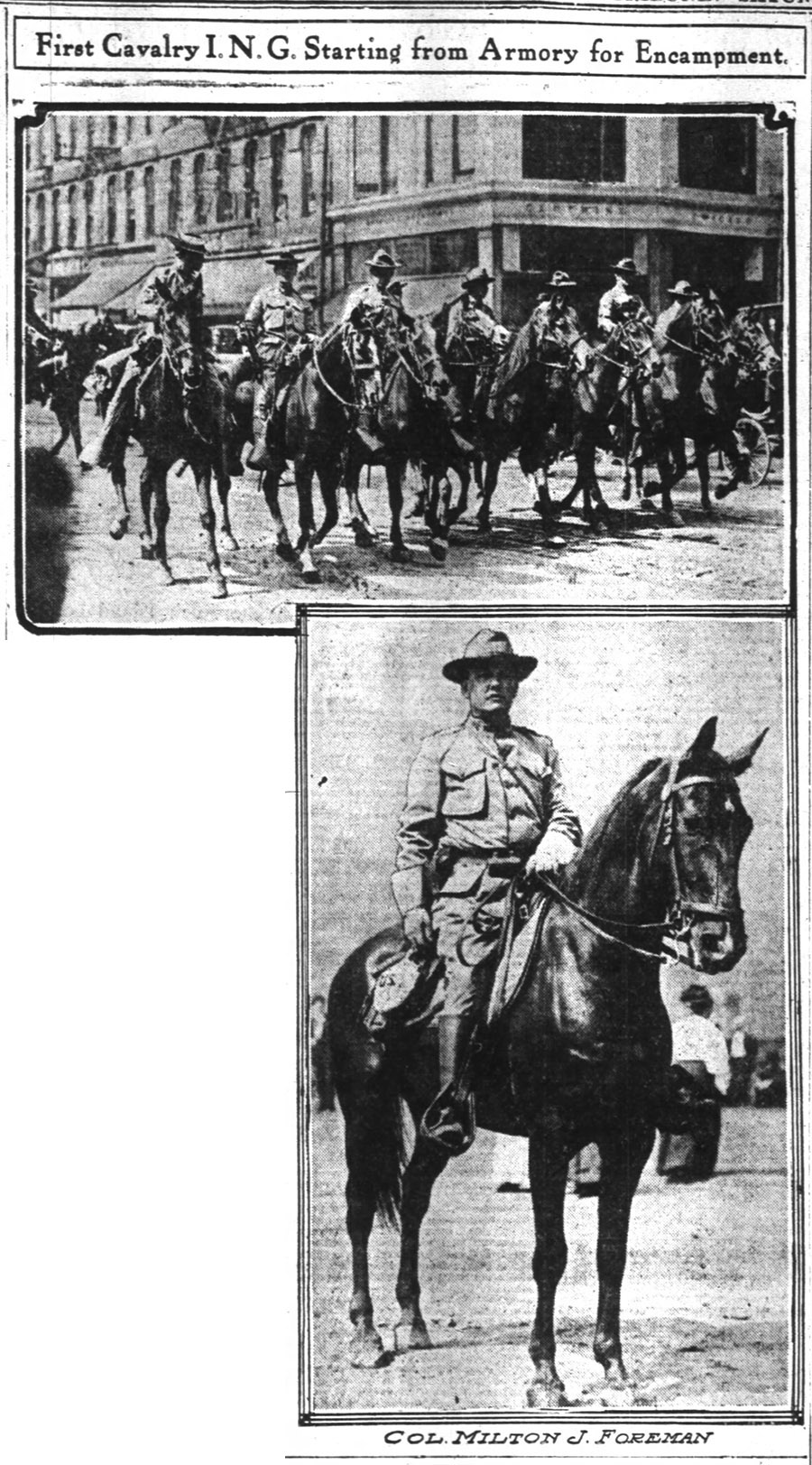
Chicago Daily Tribune, February 25, 1912
Cavalry Troop To Form Club.
Within a short time a new troop, composed of business and professional men, is to be added to Chicago’s complement of the National guard. The new addition is troop H of the First cavalry, and it is now being recruited. It is the purpose to make the troop as much of a “crack one” as possible, and many of the club features which have been prominent in the First cavalry are to be present here also. As soon as the troop is recruited to its capacity a club is to be formed among the members and entertainments are to be given at various times throughout the year.
As the First cavalry has many of the prominent business and professional men among its members it has never neglected the social side of military life. And, although it does not contemplate any lavish expenditures, the new troop is also going to have its meetings, its dances, and its dinners.
The formation of the new addition to the Chicago contingent of the First cavalry came about through the mustering out of the old troop H, stationed at Macomb. The members of that troop were transferred to the Fifth Infantry and the vacancy which was left now is being filled here.
Acting Officers of the Troop.
William Hay of 1923 Sedgwick street is the acting captain of the new military group. William A. Peterson of 4017 North Whipple street is the acting first lieutenant, and Egbert Robertson, an attorney with offices at 322 First National Bank building, is the acting second lieutenant. Col. Milton J. Foreman, commanding the First Cavalry, of course, has charge of the new troop.
“We’re going to try to make an agreeable combination of social life and hard military work in the “new troop,” Mr. Robertson said yesterday. “We believe that there is a chance for the making of a crack troop there, and of course we’re going to do everything toward that end possible. Our drilling, one night a week will be done in the armory at 1330 North Clark street. The regiment is to furnish the horses, while the state will furnish all the equipment necessary – uniforms, rifles, revolvers, sabers, and all that goes to the making up of a troop.
“On that one night we’re going to work as hard as it is possible to work. Most of the drilling will consist of bareback riding, and saddles will be used only two or three months of the year. Then, when summer comes, there will be the riding on the bridle paths, the encampment of eight days, and various practice marches.
Club Gives Social Aspect.
“But in the meanwhile, between times there will be little social functions that will be arranged after we have formed our club. That is one of the good things about the National guard in Chicago. Nearly every troop has its little club, with nominal dues, yet enough to assure us of something always to look forward to.
“We believe that the fellowship spirit is helped along a lot by the club spirit; that the members of the troops have a much better time than if their sole mission in belonging was only to drill and to study the fine points of war and military life.”
|
Within ten years, the First Illinois Cavalry had outgrown their aging quarters and appealed for a new armory.
The Illinois General Assembly appropriated $250,000 for the cost of a site and the construction of a new building, and in October 1914, the Army Commission purchased a parcel of land at the northeast corner of Broadway and Cornelia Streets for $63,250. Immediately, the neighbors in the vicinity complained about the armory's placement in their backyard, and in ten weeks, the Cavalry was looking for a new site.
On January 5, 1915, the Tribune reported that the Cavalry was considering putting the armory in Lincoln Park: "The site of the old park barn, near the north lagoon, was under discussion. Nothing definite was decided. Governor Dunne is said to favor the plan, but will not give out his official O.K. until he feels the pulse of the north side residents on the proposal." The proposal was met with uproar from neighbors and was also legally challenged on the grounds that the State had no authority to exchange land with the Lincoln Park Commissioners.
|
Chicago Daily Tribune, April 6, 1913
 |
Chicago Daily Tribune, May 5, 1914
PROVISION FOR THE GUARD.
The situation is desperate. The First cavalry is housed in a shack forty years old. Between 400 and 500 men change their clothes in rooms without change of air, without heat, outside light, or ventilation of any sort. One troop is quartered in a hay loft. Conditions are such that the equipment ?? no matter what precautions are taken. Hang up a saddle tonight; and in the morning it is covered with mold a quarter inch thick. We never have asked th estate for a cent for maintenance or repair of this armory, - Col. Foreman’s appeal for an appropriation for the armory.This statement ought to reach the self-respect and sense of justice of every citizen in Illinois. The conditions described are a disgrace to the state and an outrage upon men who are giving their time and their effort to the public service.
A few miles from Springfield, in the city of St. Louis, they are holding a peace conference. At that meeting Mr. Carnegie put the childish question: “Who is afraid of the Japs? Every one in the hall who is not afraid of the Japs rise.” Every one, it is reported, rose, thus giving a thrilling exhibition of valor and a proof highly satisfying Mr. Carnegie that we need fear no foe.
Our policy, written in blood and waste, is to be insolent and unprepared, to be ignorant ourselves and contemptuous of others, to misread the lessons of our history and ignore the lessons taught by the history of other nations, to be militant and unready, aggressive in peace and unfit to make war. While ending lavishly the public funds, we begrudge the navy, the army, the national guard every cent wrung from us in their behalf. This is the policy of folly. Its price has been heavy. It may be heavier. Certainly it is unworthy of America.
Illinois should provide adequately for its national guard. Its policy should be to encourage its young men to perform the duty of citizenship which in other countries is exposed by law upon all who possess the privilege of citizenship. Our system is to depend on volunteers. There is, therefore, all the more need to show that service is appreciated and honored.
Chicago Daily Tribune, October 23, 1914
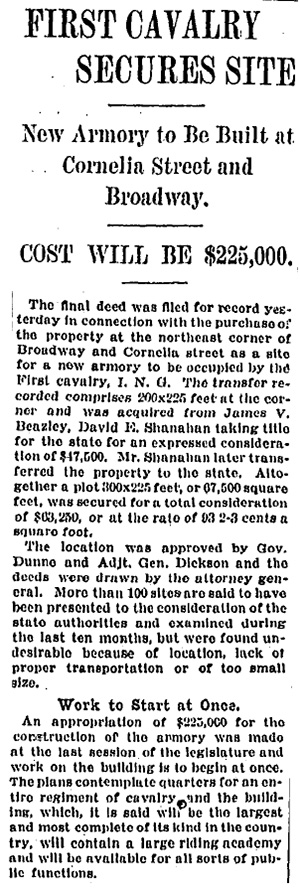 |
Chicago Daily Tribune, April 12, 1914
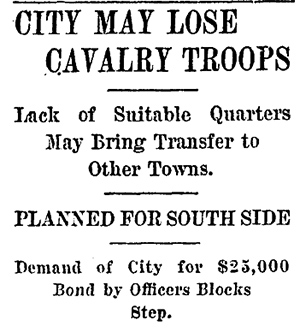
Chicago Daily Tribune, May 25, 1914
VOICE OF THE PEOPLE
NEGLECT OF THE GUARD
Chicago, May 22, - [Editor of The Tribune.]
If the First cavalry, Illinois national guard is afforded the same facilities and given the same advantages as those afforded to the regular cavalry, it will be as immediately effective for war purposes as its brethren in the regular army.
What the facilities and advantages are that it does not possess can be easily stated. First and foremost, the service itself should be without any loss or sacrifice to the men excepting their time. All expenses incidental thereto should be taken care of.
Records are required to be kept and reports made in a particular manner. This takes all the spare time of a trooper, who is unfortunate enough to have clerking capacity. He should be compensated for his services.
The proper keeping of records and care of property are rightfully essential requirements of the war department. Quartermaster sergeants and first sergeants receive no compensation for their labors, which must be done in their spare time, and in consequence the property and records are in many instances attended to in a slipshod manner.
Officers must now pay for their uniforms, which are part of their required equipment, and should be paid for out of military funds.
Adequate provision should be made for proper conduct of the regimental adjutant’s office. He is the business manager of the regiment and upon him depends more than upon any other man the cohesion and unity of the regiment.
Adequate armory facilities should be furnished: a riding hall in which a troop may be maneuvered, necessary rooms for strictly military purposes, stables for 300 horses, pistol and rifle galleries, and a place to wash.
An outdoor drill field within short reach of the city should be provided. Forage should be raised thereon and cavalry horse breeding on a small scale engaged in.
Men are now required to pay their own subsistence at the rifle range. This is unjust and militates against the enthusiasm which accompanies this branch of the service.
The horses which are used by the First cavalry were bought and paid for out of private funds. The regiment should have typical cavalry horses to mount a squadron and an allowance for forage and maintenance.
The weak point of all national guard organizations is their inability to cook. Graduates of the federal school of cooking at Fort Riley should be detailed and instruction should be compulsory.
Regular army escort wagons should be issued. Now we use farm wagons, which were bought with private funds. Men must be taught to pack wagons as prescribed by field service regulations. For service in Mexico pack mules will be used and a sufficient number should be issued to train men in this form of transportation.
Machine guns have never been issued to us. Training therein is as important as in the rifle or revolver.
The national guard is only in a minor characteristic a state force. It by law has been made a part of the regular army, and therefore it should be fully supported by the federal government. It is intended as a substitute for a standing army, and should be treated as such.
So long as the same facilities and advantages are not furnished the organized militia as are given the regular army, it is unfair and absurd to compare their respective efficiency.
Milton J. Foreman, Colonel First cavalry. |
|
Chicago Daily Tribune, March 12, 1915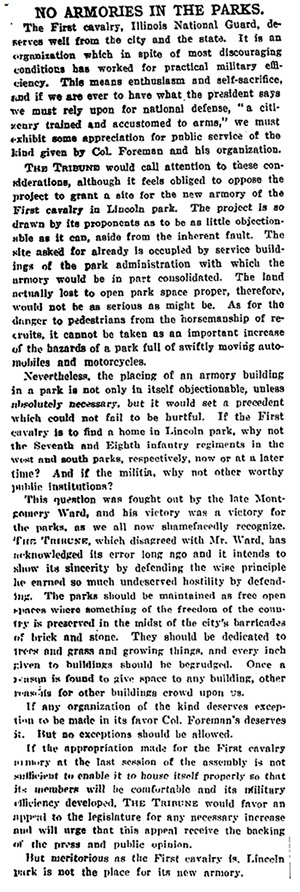
Chicago Daily Tribune, March 19, 1914
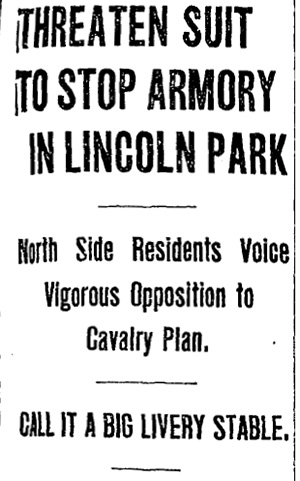
(Excerpts):
Several persons assert that they will carry the matter to the courts before they allow the armory to be erected in the park.
Daniel F. Crilly, for years a member of the south park board of commissioners said yesterday he is ready to fight the erection of the proposed armory in the park if necessary. Mr. Crilly owns property adjacent to the park.
“In the first place,” he said, “it is establishing a precedent that is dangerous. That alone ought to be enough to prevent the erection of the armory. Lincoln park is the most congested park in the city.
Sees Danger to Pedestrians.
“My friend, Cy De Vry, tells me that some days there are as many as 175,000 visitors in the park. You’ll get a lot of fellows enlisting over there who have never been on a horse. They’re going to run over someone. The proposed site is near the zoo, where the crowds are the greatest.
“Montgomery Ward told me in California some time before he died that he spent $150,000 trying to keep buildings out of Grant park. Think of what a wonderful fight it was. Greatest victory in the world. We haven’t buildings in Grant park and we’re not going to have them in Lincoln park.”
Advises State Buy a Site.
Joseph E. Otis, 1441 North State street, said he is extremely opposed to the proposition.
“Lincoln park should be as free as possible of buildings,” he said. “It is not large and is not a good place for an armory. If the state wants to give an armory it ought to be able to afford to buy a piece of land for it. I don’t see why they should settle down in one of our beautiful parks.”
“I am strongly opposed to the plan to place the armory in the park,” said George E. Marshall, 574 Hawthorne place. “I believe it would amount to a great big livery stable. There will be several hundred horses, and I am informed that these are to be rented out by the hour.
Holds Sanitary Objections.
“A livery stable in a residential district is a thing of the past. It would be offensive and unhealthy. Furthermore, the park is a place of recreation for women and children. If there were this vast number of equestrians riding back and forth it would be objectionable to the women and children.”
Several protests already have been sent to the Lincoln park board. Among those who have objected are Arthur Meeker, Samuel Dauchy, David Revell, Herman H. Hettler, W.E. WRoe, John McConzell, Benjamin Bear, John L. Shortall, and Nathan William MacChesney.
“In spite of the most extreme precautions,” said Mr. Dauchy, who lives at 525 Hawthorne place, “such a building would cause the breeding of obnoxious insects. The size will materially obstruct the view of the lake and the park behond the building.”
Chicago Daily Tribune, March 24, 1914
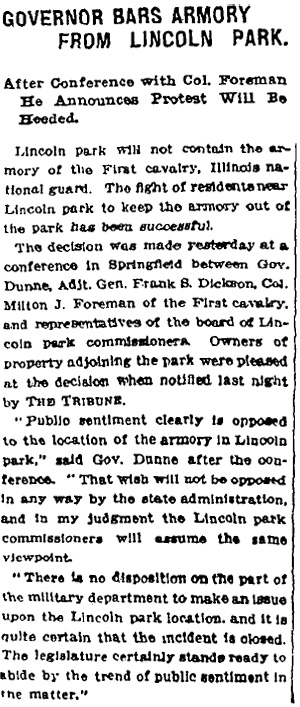
|
|
|
| |